The Best Men’s Winter Running Apparel 2024
This article originally appeared on Outside
Winter running demands adaptability, from you as well as your apparel. For you, that can mean shifting planned workouts to different days, limiting yourself to several small loops of plowed road, or even, heaven forbid, scratching your run entirely. For your apparel, that means performing well in frequently changing weather, whether that's day to day, week to week, or from the start to the last few miles of a run.
This winter running apparel guide accounts for all of those winter inevitabilities. Our team of testers put in almost 2,000 miles in every conceivable condition to determine the highest-quality, most versatile winter gear currently available. The 17 items below emerged as stellar in their category.
The Winners at a Glance:
Editor's Choice: Best Pants: Tracksmith Bislett Pants
Best Base Layer Top: Pinebury Portland LS Performance Tee
Best Top For Running and Everyday Life: Appalachian Gear Company 8020 Long Sleeve Tee
MVP (Most Versatile Piece): Rabbit Cocoon 2.0
Best Shell: Houdini The Orange Jacket
Best Heavier Jacket: Fjallraven Keb Fleece Hoodie
Best Underwear: Tracksmith Brighton Boxers Briefs
Best Tights: SaySky Blaze+ Long Winter Tights
Best Leggings: Minus 33 Woolverino Midweight Flyless Running Tights
Best Thicker Socks: Walter Sky Merino Wool Athletic Sock
Best Thinner Socks: On Performance High Sock
Best Neck Gaiter: Skida Snow Tour
Best Light Hat: Artilect Darkhorse Skully Beanie
Best Heavy Hat: Ciele Athletics VNT Beanie
Best Gloves: Soar Winter Gloves
Best Mittens: Rab Xenon Mitt
Best Gift: Outdoor Vitals Tern Ultralight Merino Wool Hoodie
The Reviews: Best Winter Running Apparel
Editor's Choice
Best Running Pants: Tracksmith Bislett Pants ($198)
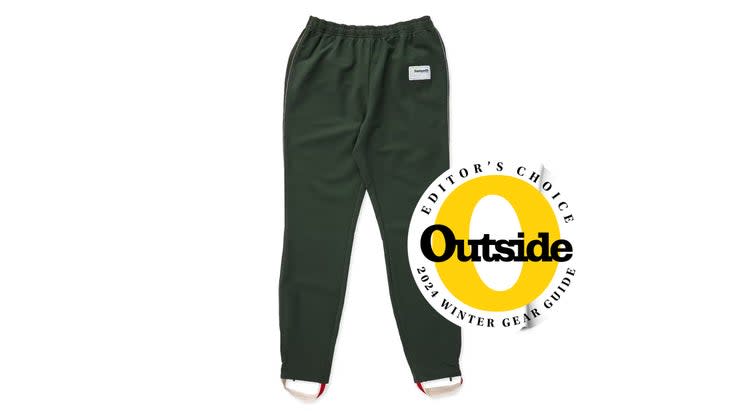
Sizing: XS-XL
Sometimes the greatest isn't the latest.
I bought the Bisletts when they first came out in 2014, and they've been my main winter running bottoms since. I've tried dozens of other pants and tights since then--including the latest and greatest--but none are better. The only real difference between the OG version and the current Bisletts is a thicker drawstring in the newer offering. So, kudos to Tracksmith for not pointlessly tinkering with an already superb product.
What's so great about the Bisletts? I consider them do-it-all winter running bottoms. They combine the performance of a tight with the comfort (and modesty) of pants. They have just the right amount of looseness and stretch throughout to move with me no matter the run, from recovery jogs to repeats at 800-meter race pace. The four-way stretch fabric (63 percent nylon/31 percent polyester/6 percent elastane) is soft, wicking, and water-repellant. I've worn them comfortably up to temperatures in the mid 40s Fahrenheit, and I turn to them in sub-zero conditions. On brutally cold days, they easily accommodate a pair of briefs and half tights underneath.
I also appreciate the pants' practical details. The side seam pockets are stealth but are large enough to hold a car fob, credit card, or phone. The side zippers extend to the top of the calf, making it easy to remove or pull on the pants without taking off your shoes on cold days. Full-length lateral reflective piping adds utility.
Yes, the Bisletts are pricey. But consider this: After thousands of miles in all that Maine winters have thrown at them, my pair from 2014 is as good as the Bisletts I got almost a decade later. That's my definition of a good value.--Scott Douglas, category manager, lead tester
Best Base Layer Top: Pinebury Portland LS Performance Tee ($108)

Sizing: XS – XXL
If you're a merino wool-lover who hasn't yet experienced Nuyarn, here's the lowdown: Nuyarn is a two-ply strand of merino spun around a nylon core. Because the yarn isn't twisted, as with standard merino/nylon knits, the merino fibers are better able to insulate and wick. The construction also leads to fabrics with five or more times the durability of conventional merino yarns. This U.S.-made shirt is a great example of what this new wool-nylon technology delivers. At 145 grams per square meter, the Portland Long Sleeve Tee is lighter than most midweight merino tops, but just as warm. The shirt hits at or just below the belt line, with a close but not clingy fit that enhances its breathability. We comfortably wore it as a base layer at temps below freezing and as a solo top into the low 50s Fahrenheit.
Bottom line: A soft but sturdy, light but warm, functional but fashionable staple
Best Top For Running and Everyday Life: Appalachian Gear Company 8020 Long Sleeve Tee ($102)
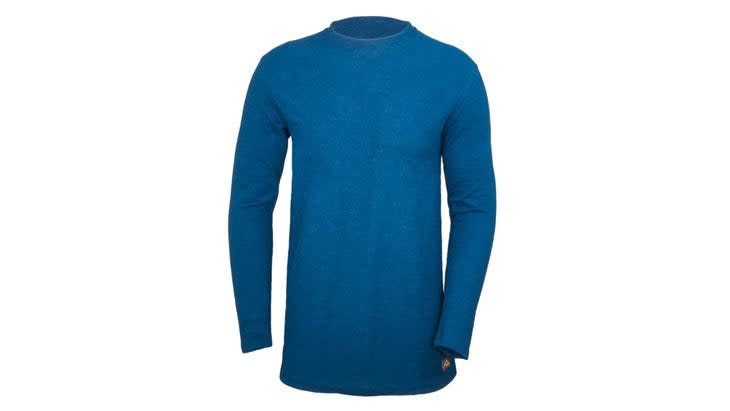
Sizing: Women’s XS-XL, Men’s S-XXL
No shirt we tested better straddled the divide between great performance on winter runs and comfort and good looks in everyday life. (Great colors!) Steve and I generally wore this top for a few days in our non-running hours, then used it for running for several days before washing. The all-natural-fiber mix of 80 percent alpaca wool and 20 percent Tencel has a slightly heavier feel than most midweight merino wool tops, yet remains soft and non-itchy--plus, like merino, it doesn't absorb odors, even after several sweaty runs. The fit is snug enough for the top to work well on its own, but loose enough for it to be worn without constraint over a tighter base layer and to drape well as everyday wear. I watched in wonder on one snowy run as the flakes slowly melted on the shirt's surface, but no external moisture reached my skin.
Bottom line: A true daily life/running hybrid that's warm, comfortable, and attractive
Sponsor Content
Seirus Men’s Mapped Base Layer Top ($129.99) and Bottom ($119.99)

Crafted with precision, this base layer uses three carefully selected high-performance fabrics to enhance your wear experience. It delivers targeted warmth precisely where you need it most--all while maintaining exceptional breathability in heat-prone zones thanks to the strategically placed Max Wick fabric. To keep you feeling fresh, the Polygiene antimicrobial mesh is positioned in the highest vent areas to ensure breathability. What truly sets this base layer in a league of its own is our exclusive Heatwave(tm) heat-reflective technology, where heat reflection and amplification combine as an unmatched powerhouse. Experience the perfect fit and the power of performance on any adventure that comes your way.
MVP: Rabbit Cocoon 2.0 ($125)
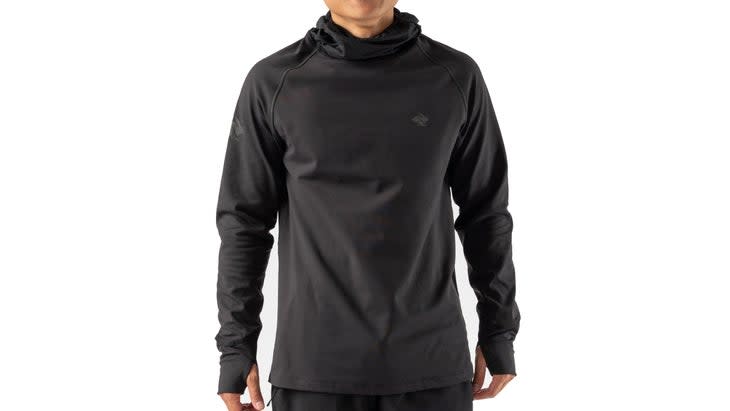
Sizing: S-XL
That's "MVP" as in "most versatile piece." If this top were on a track team, it would be the guy who's not a star in any one event but can run a good 800 meters, hold his own in any relay race, and score a point or two in a field event. The aptly named Cocoon has a soft, loose, built-in turtleneck that can be pulled into a hood, a face mask, or both. The body of the piece is 77 percent polyester/23 percent spandex with a fleece lining and semi-relaxed fit. It performed equally well whether worn as my only top in temperatures around freezing, as an outer layer when temps were in the teens, and as a mid layer on the most bracing Maine mornings.
Bottom line: Versatile top that might be worn in three ways within a week
Best Shell: Houdini The Orange Jacket ($300)

Sizing: XXS – XXL
A $300 jacket from a company named Houdini better have magical qualities, and this one does. It's soft, breathable, waterproof, and incredibly light (a men's large weighs less than 7 ounces). I returned from one Maine run in heavy snow to find the shirt I had on under the jacket was completely dry. Conversely, on a dry day with temps in the 20s, I could see the sweat that had been wicked to the jacket's exterior, but not feel it inside. The fit is generous enough to accommodate two layers beneath, but close enough to keep the jacket from billowing. This was also the quietest weather-resistant jacket in the test, with weather-resistant exterior treatments. (FYI: The name comes from the jacket's ability to tuck into itself to citrus-fruit size, not from its color. You can also buy The Orange Jacket in black or blue.)
Bottom line: A highly-functional, superlight shell that will make you feel invincible to the weather
Best Heavier Jacket: Fjallraven Keb Fleece Hoodie ($210)
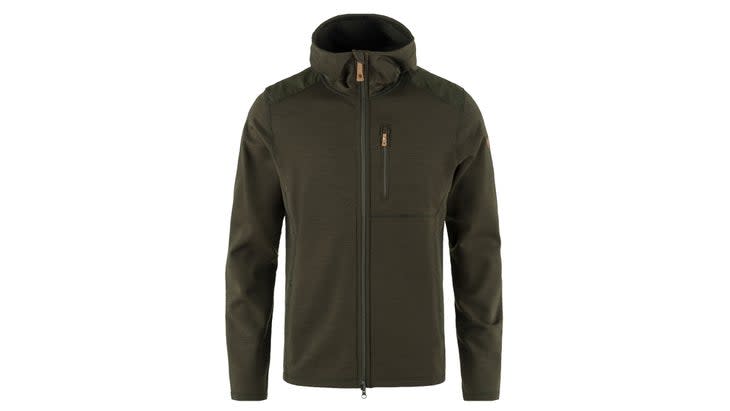
Sizing: XS-XXL
What Fjallraven calls a mid layer for trekking, we call a surprisingly awesome outer layer for winter running. The polyester/wool/elastane blend is warm and breathable without being heavy. The fit is snug but allows full range of motion. The brushed interior provides just the right touch of coddling in the cold. The hood slid perfectly over a hat for the opening minutes of especially cold runs, and stayed put once I flipped it back. Because of the wool, snow melted on the exterior, rather than permeated the tight weave. I wore the Keb comfortably over a light merino long sleeve in single-digit temps. I even got a little toasty on one below-zero-windchill 90-minute run with this as my outer layer. Bonus: It became a staple of my non-running wardrobe once wintry weather receded thanks to its warmth-to-weight ratio and sleek good looks.
Bottom line: A warm zip-up that you'll also want to wear for less strenuous activities in warmer months
Best Underwear: Tracksmith Brighton Boxer Briefs ($48)
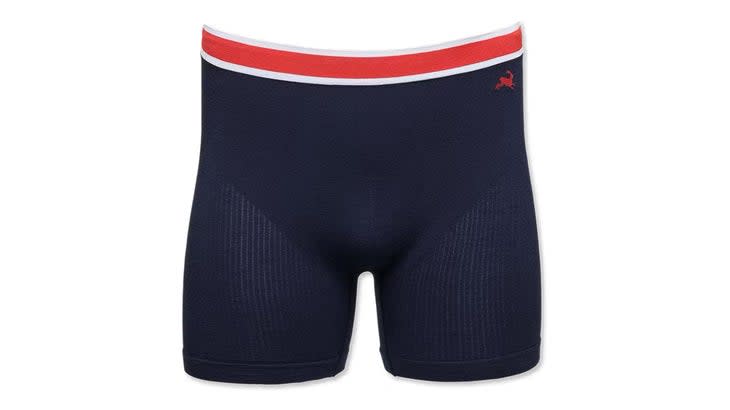
Sizing: S-XL
Take it from someone who has endured frostnip down there: Nothing is more important than a good pair of underwear when running in particularly harsh winter weather. Merino wool is a no-brainer for warmth, comfort, and moisture management, but that should be the starting point. Where these Tracksmith boxers shine is the attention to detail. Seamless construction greatly reduces the chances of being rubbed raw and holes developing. Durability is enhanced by the merino/nylon/elastane blend. "They contour everything really well, nothing feels restricted, but everything feels secure," Nathan said. I even became a boxers convert, because there's just the right amount of give in the thigh to provide extra coverage without being constraining. Nathan and I wore these almost daily, from sub-zero temps up into the low 40s.
Bottom line: Supremely comfortable guard against the worst kind of frostbite
Best Tights: SaySky Blaze+ Winter Tights ($156)

Sizing: XS to XL
Of the nearly 15 classic-profile tights we tested, these Danish ones most often hit the Goldilocks just-right mark. They're snug but not uncomfortably so, and warm into single-digit temps, but not too hot in the mid 30s. Jonathan noted that, "despite the thicker weave, the tights didn't affect mobility, breathed nicely when I got sweaty, and provided some comfortable compression. Plus, the soft and warm feel of the interior against my skin helped me get out the door in blizzard conditions." The external side pockets are great for stashing a hat or gaiter mid-run.
Bottom line: Protective but not restrictive tights that perform well in a wide range of conditions and paces
Best Leggings: Minus 33 Woolverino Midweight Flyless Running Tights ($85)

Sizing: S-XXL
These no-nonsense leggings are one of the best values of any item we tested. For less than $100, you get as much quality, comfort, and performance as you would in bottoms costing twice as much. The 85 percent merino wool/13 percent nylon/2 percent spandex weave is soft but sturdy. "The fit is loose and comfortable, but not baggy," Jonathan said. "They never got in the way, but my legs didn't feel like constrained sausages like they can in tights." As for performance, I wore them comfortably on the coldest day of our testing, when the windchill was--wait for it--minus 33. Yet Jonathan also found them to be breathable up to 50 degrees if not working too hard. Our main wish for improvement is an outer pocket for stashing gloves, a hat, or phone. (There's a small internal pocket that can accommodate a credit card or car fob.) But at this price point, it's hard to complain.
Bottom line: Top performance and comfort at a moderate price
Best Thicker Socks: Walter Sky Merino Wool Athletic Sock ($23)

Sizing: Men’s 6-10, Men’s 11-13
It can be tricky to find the right socks for running on really cold days. Your inclination might be to wear the thickest socks you have. But those don't always fit comfortably inside your running shoes. These Nuyarn socks (40 percent merino/20 percent nylon/40 percent Lycra) solve the problem: Extra cushioning in the heel and ball of the foot is offset by a lighter mesh elsewhere to produce a medium-thick fit with an incredible warmth-to-weight ratio. The mid-calf length stays in place throughout runs. These were my go-to socks on the many single-digit-temp-or-colder days of a Maine winter.
Bottom line: Warm enough for the coldest days without confining your feet
Best Thinner Socks: On Performance High Sock ($25)
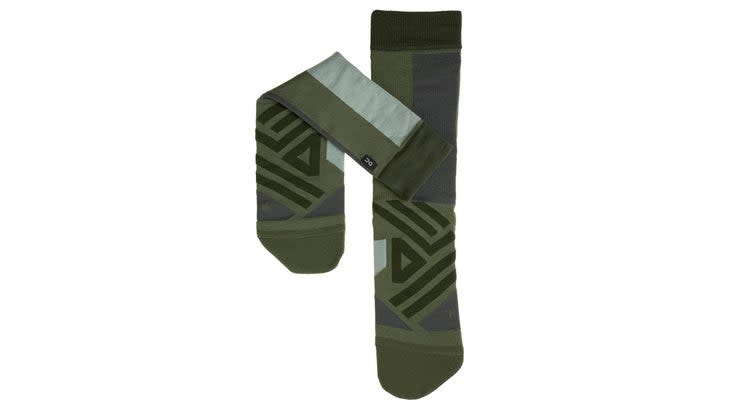
Sizing: S-XXL
Even when temps aren't bitingly cold, most winter runners appreciate a little extra coverage from their socks. These beauties from On, made of a snug but uber-comfortable 90 percent recycled polyester weave, extend just over the bottom of your calves. They were our top choice for workout days, given that many racing shoes and performance trainers have a closer fit than standard running shoes. They kept our feet plenty warm down into temperatures in the teens. Finally, these are simply great-looking socks, with fun patterns and nice color combos, and we enjoyed showing them off when it came time to run in shorts.
Bottom line: A stay-put, partial-calf-covering sock you'll want to wear year-round
Best Neck Gaiter: Skida Snow Tour ($24)
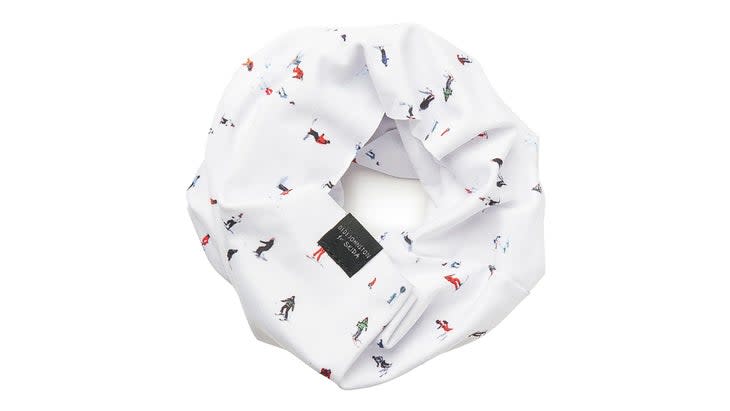
Sizing: One size
A good gaiter is a godsend. It keeps your neck warm, of course (and therefore the rest of you, thanks to the carotid artery). It can also cover your lower face on especially brutal days, and can convert to a headband or open-top hat on mild days. Skida's heaviest version is 92 percent polyester/8 percent spandex, with a brushed interior to prevent chafing. We happily wore it in every conceivable way throughout the winter. We also appreciated its UPF 50+ rating and that it's made in Vermont.
Bottom line: Versatile neck chute that can fill many roles over the course of a winter
Best Light Hat: Artilect Darkhorse Skully Beanie ($35)
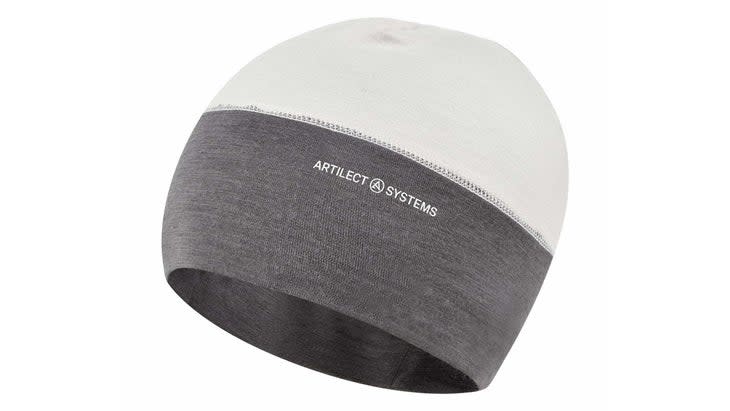
Sizing: One size
Many runners don't need (or want) a thick, heavy hat for their winter miles. Even those in harsh climes like to have a lighter alternative on moderate days. This beanie kept us comfy in temps to the low 20s, but didn't overheat us on sunny, above-freezing late-winter runs. The fit is dialed in--snug, but with just enough give that it doesn't feel like a skull cap. The merino wool/nylon yarn is soft and smooth, quickly moved sweat to the surface for evaporation, and didn't smell even when worn often enough to form salt lines.
Bottom line: Great fit, comfort, and warmth-to-weight ratio in a lightweight lid
Best Heavy Hat: Ciele Athletics VNT Beanie ($75)
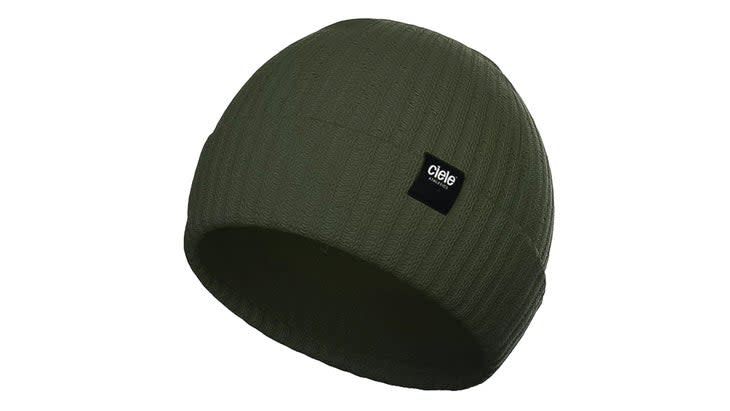
Sizing: One size
"The Ciele thick-ribbed beanie was wonderful," Nicholas said, after wearing it through a Montana winter. I agree! Made of a 90 percent merino wool/10 percent silk knit, the hat is form-fitting, not bulky, and oh so soft. Nicholas and I felt invincible wearing it in temperatures in the teens and lower. The rib-knit construction has sewn-in vents that kept our heads from getting too hot and sweaty during harder runs. Nicholas described it as "one of the best hybrid items," that "can work both as performance wear and something to take to the cafe." Once again, I agree.
Bottom line: Great-looking, warm watchman's cap that's snug without being confining
Best Gloves: Soar Winter Gloves ($50)

Sizing: S, M, L
If your winter running doesn't merit mittens, these might be the only gloves you'll need. The Soar Winter Running Glove has a fleece lining, breathable outer layer, cuffs that extend about an inch past the wrist, and touch screen compatibility. They're plenty warm into temps in the low teens, but also not hot into the low 40s. "The fit is really dialed in--yes, even for a glove--and the material is a great match between stretch and soft," Nathan said. "They felt like performance gloves and stayed out of the way while keeping my hands warm."
Bottom line: A versatile glove for runners in moderate climates
Best Mittens: Rab Xenon Mitt ($55)

Sizing: XS-XL
These are the best mittens I've ever run in. Others that kept my hands warm enough were too bulky for normal arm action, bumping against my hips with each swing, and sometimes got too hot. Those that didn't interfere with my form didn't keep my hands much warmer than gloves would have. The Xenons are the best of both worlds in single-digit-and-below temps. PrimaLoft insulation is covered on the back by a weather-resistant Pertex shield. The smooth, palm-side fabric doesn't irritate when you wipe your face with it. The mittens are pliable enough they can be packed into themselves, and conform comfortably to your hands when you run in them. I also appreciated how the elastic cinch at the wrist seals in warmth while making it easy to pull the remaining inch-plus of the cuff over garments or to peel the cuff back to check my watch.
Bottom line: A light but super-warm, comfortable mitten that allows normal running form
Best Gift: Outdoor Vitals Tern Ultralight Merino Wool Hoodie ($85)

Sizing: XS-3XL
Our criteria for this category: Something you might not consider a core piece but that, once you have it, you find yourself wearing again and again. This thin, light (115 grams per square meter) Nuyarn top is made of a soft, 58-percent merino wool/42-percent nylon blend. It fits closely but not tightly. It's great for running, either on its own on mild days or over a long-sleeve top on cooler ones. I also wore it often for daily life, both indoors in the winter or as a light pullover on warm spring days. Whether you gift it to someone else or yourself is up to you.
Bottom line: Who wouldn't love to receive a versatile, high-performing, attractive merino hoodie?
How to Buy
Dressing for winter running can be tricky because of the great range of conditions you can face. Here are some tips on how to focus your wardrobe-gathering efforts.
Love the layers: Think in terms of layers of clothing that will wick sweat (base layer), keep you warm (mid layer), and keep exterior moisture from reaching your skin or block the wind (outer layer). Adjust as necessary for the day's conditions. Here's a detailed tutorial on layering.
Shop to your local norms: When I lived in Maryland, I focused on having a good collection of light- to medium-weight tops, and few thick, insulated shirts or jackets. I figured I could cobble together an adequate outfit on the handful of bitterly cold days. Apply that principle to whatever is typical for your winter running weather, rather than, for example, getting a blizzard-ready jacket or superlight gloves that you'll wear only a few times a year.
Invest in quality: If possible, be willing to spend more up front for top-quality construction and fabrics. Ultimately, you'll save money by having apparel that's as good as new after several years instead of frequently buying replacements because more cheaply made ones keep developing holes or falling apart at the seams. Also, higher-quality materials will feel and perform better, and isn't your running worth that?
Consider your colors: Many winter running pieces are dark, in part because they better absorb the warmth from weak sunlight. Dark colors also help you stand out in areas with months of roadside snow. But winter running can also mean more miles in the dark. If that's what your schedule requires, look for apparel with reflective elements.
And once you've shopped: Dress for how warm you'll be 15 minutes into your run. It's better to be a little chilly for a little while than too warm for too long. An exception: If you're planning to run for less than half an hour on a miserable weather day, pamper yourself and overdress if that's what it takes to get out the door.
How We Tested
Number of testers: 7
Number of brands tested: 44
Number of items tested: 135
Number of testing miles: 1905
Lowest testing temperature: -15 Fahrenheit
Lowest testing wind chill: -33 Fahrenheit
We assembled a band of dedicated runners spread over a wide range of winter climates--Chicago, Seattle, coastal Maine, the mountains of Montana, the high plains of Nebraska, upper Minnesota, and the middle of Maryland. (Sorry to our comrades in New Orleans, but "This might be one of the five days a year I need long sleeves" wasn't the testing weather we were looking for.)
Our testers had a simple charge: Do as much of your running outside in this gear as possible. Be willing to get cold, wet, iced-over, and windblown. Report back on which pieces kept you the most comfortable while not interfering with your running form.
Versatility and durability were focal points. The items below performed exceptionally well in a great range of conditions and showed little to no signs of wear, which means you can wear them more often and have to buy fewer pieces.
While this is a running-focused review, many of our winners are great for non-running activities. Whether that non-running use comes in intense winter activities like skiing or climbing, or for more leisurely pursuits, every new use adds chits in the value and versatility score of the apparel.
Meet the Testers
Scott Douglas, Lead Tester:
I started running as a middle schooler in 1979 and have done more than 125,000 miles since. I was pretty good decades ago--30:48 10K, 68:40 half marathon--but have always run primarily because I love it. I run every day unless I'm injured, and I always run outside, either despite of or because of living in Maine. Even a slippery, sloppy, snowy run is more enjoyable to me than waiting out the time on a treadmill. In my late 50s, I run about 3,000 miles a year and am now most drawn to trail ultras.
I'm fortunate to be able to combine my love of running with my professional life. I've held senior editorial positions at Runner's World and elsewhere, and have written or co-written several popular running books, including Advanced Marathoning, Meb for Mortals, Running is My Therapy, and Strong Minds.
Our Other Testers Were:
Jonathan Beverly: Senior running gear editor for Outside, 40+ years running, lives in western Nebraska
Nathan Brown: Doctor of physical therapy and head of Pineries Running Lab, lives in Wisconsin
Greg Crowther: College instructor in anatomy and physiology, winner of JFK 50-miler and other ultras, lives in Washington
Steve Kartalia: Two-time Olympic Trials qualifier, 40+ years running, lives in Maryland
Matt Krecun: Marathoner since the 1990s, 3:31 at 2023 Boston at age 51, lives in Illinois
Nicholas Triolo: Senior editor for Outside and Trail Runner, lived in Montana during winter testing
For exclusive access to all of our fitness, gear, adventure, and travel stories, plus discounts on trips, events, and gear, sign up for Outside+ today.

